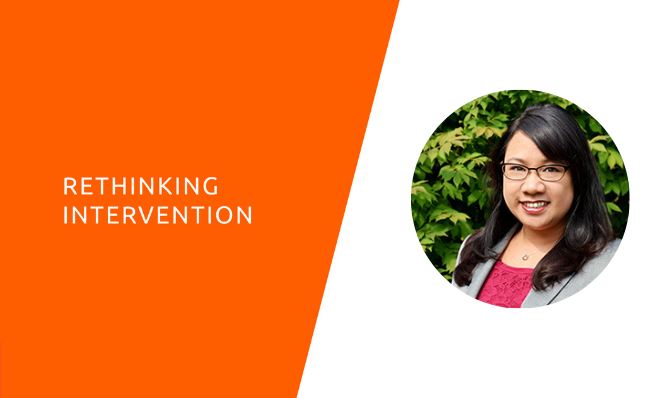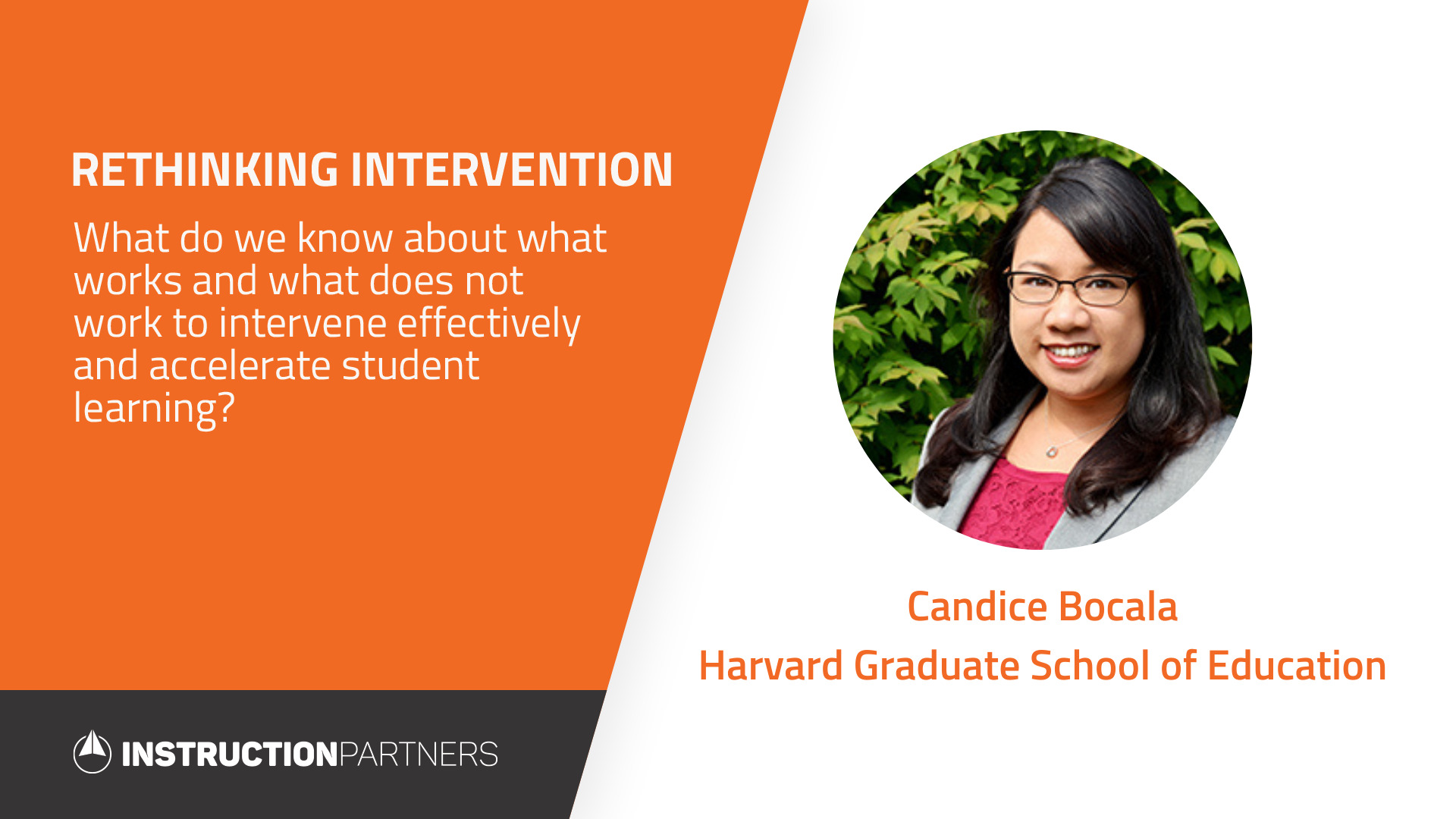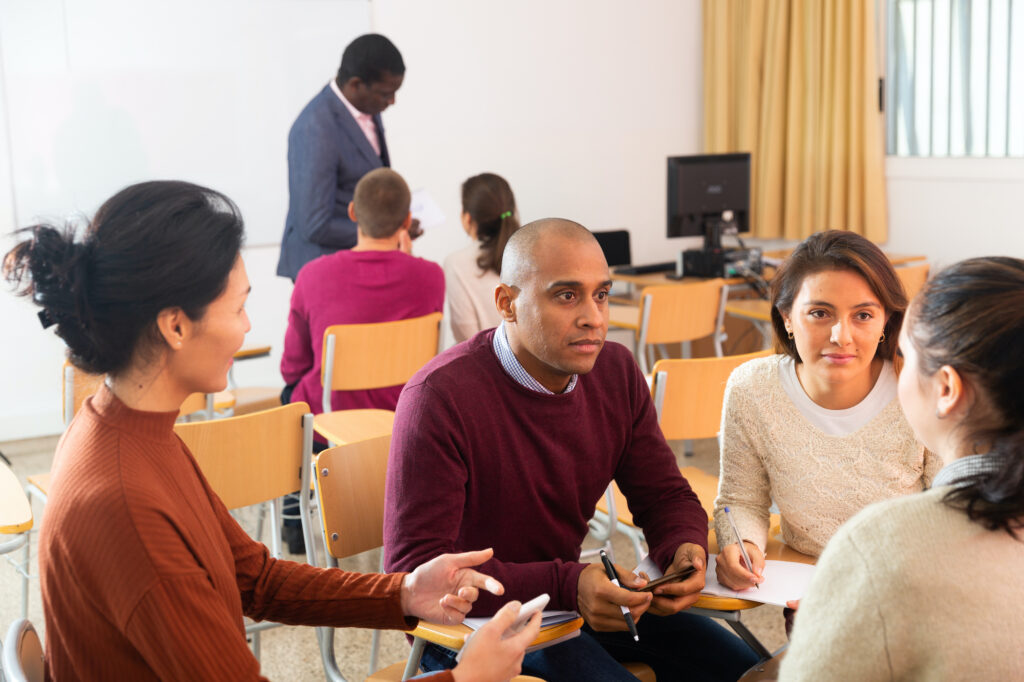
Candice Bocala, Harvard Graduate School of Education
Candice Bocala is a lecturer at the Harvard Graduate School of Education. Her research focuses on the connections between educator learning and organizational conditions that support collaborative work. She is a co-author of The Internal Coherence Framework: Supporting the Conditions for Continuous Improvement in Schools (Harvard Education Press, 2017), which introduces a set of clinical tools for school educators to coherently align resources and professional learning with their instructional vision.
Candice spoke to Emily Freitag about necessary conditions to support instructional improvement. Watch the full conversation or read the abridged Q&A below.

EF: I’d love to hear a little bit about your journey as a learner and what that has taught you about learning.
CB: This is a really useful reflective question. In thinking about this today, I’ve taken myself back a little bit to what influenced some of the big ideas that I’ve been working on in different ways. I am the daughter of two immigrants from the Philippines, and they came over here to the United States in the 60s. I was born here and my education has largely been in a predominantly white environment. I was a really successful student, and one of the things that stood out to me when I was reflecting back on this experience was how few opportunities I had to interact with and learn from people who were from a different culture. Specifically, in my case, people who were also Asian American or Pacific Islander. That did not factor largely into my educational career and it was not until I went to college that I had professors who were not white, and who came from different cultures and different backgrounds. One of the things that has influenced some of my thinking is how important it is for students to see themselves in the educational system and for students to have peers, mentors, role models, and teachers who come from a variety of cultural backgrounds—specifically people who look like them and can honor and understand their communities and their cultural experiences. That mattered a lot to me—more than I think I realized—and I became really interested in education partly because I wanted to make sure that there was another generation of students out there who had a really rich and culturally sensitive upbringing and educational experience.
Another moment that influenced my personal educational trajectory was back in high school, where I had a teacher who I really respected, and who was rigorous and held us all to very high expectations. He was the Advanced Placement English teacher, and he gave me the harshest feedback on my writing that any teacher ever gave me. At the time, I think I remember just feeling so crushed and so discouraged, but upon having received it, he also gave me encouragement. He said, “This is going to be hard, but I’d like you to stop writing this in this way and I want you to start writing in this other way.” So he didn’t just give me criticism, he actually gave me feedback that helped me improve and helped me to make my writing more successful. This moment really stands out to me in terms of my trajectory as a learner because the importance of both feedback and support has been something that I’ve been really interested in for not just young people who are learners, but for adults who are learners. Thinking about how we create organizational conditions in schools specifically, where teachers get feedback and support to be able to improve. That has influenced some of my work and interest in teacher learning, in teacher teamwork, and in how teachers improve their instruction.
EF: Let’s use that as a bridge into your work. Tell us a little bit more about what you have researched generally, and specifically what you have found that works.
CB: My professional interest started out in teacher learning and how we support teachers to continue to learn and grow and develop throughout their careers. This came from my experience as a classroom teacher, working at one point with a really diverse team of professionals. I was a special education teacher and all of my students had learning differences, and I worked with an occupational therapist and a speech-language pathologist. We all had very different areas of expertise, and when we came together as a team, it was a really powerful experience. What I’ve found is that very few teachers work on teams in a way that really enhances and enriches their instruction. More often, teacher teamwork is a place where teachers learn about the next staff meeting, or they plan a field trip, or they think about how to administer a test. They rarely focus deeply on instruction in a way that helps them take advantage of the different elements of expertise around the table. So my research was focused on the question, “How do teams of teachers really think about and improve their instruction over time?” Through that, I’ve been really interested in how teachers use data, not just assessment data, but all kinds of data—from student work to observations of students—and how do they take those data and think about what to do differently. My dissertation was about lesson study, which grounds teachers in real examples of student learning and evidence of student work, and then has teachers talk and engage in dialogue about content together in the presence of an instructional coach. There is always new expertise and new research that’s being brought to the table so that teachers can generate ideas and collaboratively plan their instruction. One thing that I’ve learned from both the research and my own experience is that you can’t just put people together in a team and expect them to really have rigorous conversations—there really needs to be a structure and a routine that supports teachers to use evidence, not just testing data, but evidence of student learning. Additionally, there has to be some element of instructional expertise coming into that team, as well as the support for the teachers to be able to implement whatever it is that they agree upon.
EF: That’s interesting. Can you talk a little bit more about the instructional expertise and what that can look like?
CB: I’ve seen it a couple of different ways. One is in lesson study. Lesson study is more often applied in math and science with somebody who is a content area specialist and who understands how students develop a skill over time. Lesson study is very public, and teachers go into a classroom and actually watch a teacher teach the lesson that they co-designed. When they see where students are stuck, and they see where the students have misconceptions, they bring that back to their next meeting and they wonder about that. “I wonder why students got stuck here,” “I wonder why they have this particular misconception.” An instructional expert, somebody who knows how skills develop over time might say, “Well, given what we know about skill development in geometry or number sense, it makes sense that students are stuck here. So let’s think about the next level of the students’ development in terms of a learning progression, or in terms of a next area of content that they might need to master.”
EF: So it sounds like it’s pedagogical content knowledge, not just content knowledge.
CB: Absolutely.
EF: What does that then lead to? What did you observe as the effect?
CB: One thing that happens in lesson study specifically is that teachers get better at talking to each other about their instructional practice. One of the historical detriments about the way that we’ve organized our schools is that teachers tend to operate in isolated ways. They tend to be solo practitioners. They tend to teach the way that they themselves were taught. We’ve all heard those kinds of anecdotes. So what lesson study and other team-based professional learning opportunities do for teachers is it gives them a language of instruction and helps them talk to one another and bring in the different levels of expertise around the room to actually plan and do something different in the classroom, as opposed to just doing the status quo, doing what they’ve always done, or repeating a lesson the way that they think students should learn it because that’s how the teachers were taught. By creating that deeper instructional conversation, it actually helps them to change their instructional practices in a way that other kinds of professional learning opportunities might not. If you have a teacher who goes off to a math professional development workshop, for example, but there isn’t any of that team support or that follow-up, that teacher may go back to his or her classroom and just decide, “Oh well, I’m not going to implement that because it’s hard or I didn’t really understand that concept, so I’m not going to do it.” Without the team, there’s no level of lateral accountability or reciprocal accountability, whereas with team-based professional learning, there are other people who are equally invested in my changing my own practice, and I also have a support system that I might not have had before. What we’re trying to get at is deeper student learning. If we don’t have teachers who can teach at a high level of instruction, we won’t get to that deeper student learning.
EF: Can you talk about the role of curriculum and how a team interacts with a curriculum, or how you’ve seen more productive or less productive interactions?
CB: I think the less productive interactions with curriculum utilize this idea of implementing by the book—picking something up and doing it in your classroom without actually making sense of what it is asking of the student and what it is asking of me as the teacher. In my work, I’ve seen a really high-level curriculum scaffolded so much that it takes the ownership and the agency away from the students. Let’s say there’s a very open-ended task and a really complex problem that the students have to solve. When teachers get nervous and they’re not able to understand the kind of thinking that’s required, they over-scaffold. They take everything apart and do it piece by piece, and they take that level of cognitive demand away from the students. What we found—and here I’m thinking about my experience in examining instruction through the Data Wise Project—is very often in examining instruction, teachers are doing all of the work and students are following what it is the teacher is telling them to do in lockstep, but they’re not actually engaging in that rich thinking. So in interacting with the curriculum, teachers need to be able to make sense of the level of cognitive demand required and how to keep the level of rigor high. They need to understand that they make decisions all the time and these decisions may change the level of that rigor.
EF: That absolutely maps to observations that we’ve had across classrooms. So what is it that leads to a teacher keeping a level of rigor high?
CB: I do think there is an important role for content and pedagogical knowledge, as you mentioned before. We need to have coaches and instructional specialists who can help teachers to maintain that level of rigor through their presentation of content and not hold all of the work for the students—somebody who can coach the teacher and can help the teacher see that by letting the students struggle, it’s actually supporting the students’ development and getting them to wrestle with the content. I’m a big believer in coaching and the idea that teachers get feedback and support. If teachers don’t get feedback about what they’re doing and how then to move their students to the next level, they won’t know what it is they need to improve.
EF: Let’s use that to talk a little bit about leaders and the role leaders play in creating the conditions for that kind of learning. What is it that you’ve learned? It may be the principal, it may be the leadership team, it may be a coach—I think titles matter less here than the kind of function that a leader has to play in a school.
CB: Through the Internal Coherence Project, we worked a lot on leaders creating conditions for teachers to engage in the kind of learning that I’ve described. In order to create those conditions, they have to do a few things. One is they have to be able to model learning themselves and to encourage a climate of what we call “psychological safety.” This comes from some good research by Amy Edmondson, among others. The idea is that risk-taking is no longer seen as something that is detrimental. I can take a risk, I can try something new in my classroom, I can let my students struggle a little bit and I myself as a learner and a teacher can struggle, and that will be okay. Leaders need to create these conditions so that learning can occur. The other thing that leaders can do is to organize around that powerful vision of instruction so that the teachers and the students are all moving toward the same kind of level of rigor and cognitive demand that is required of them. Usually, we talk about the instructional core. That would be a concept that comes from Deborah Ball, David Cohen, Richard Elmore, Elizabeth City, and others who have written about the interaction of the learner and the facilitator in the presence of content. The idea is that if you organize around the kind of learning you want to see in the classroom, at the most micro level, the rest of your school organization should match that. So we’re not organizing around just getting students into smaller classes. Why do we want students in smaller classes? It’s because we want more teamwork or student-to-student talk and less teacher lecture and more hands-on project-based learning, perhaps. So there needs to be a reason behind structural and organizational changes in a school, not just because we like to move the chairs and the furniture, it has to relate somehow to that vision of instruction that the leader has.
EF: This requires the leader to have a pretty significant instructional vision. Is that true?
CB: Yes. When we talk about this in Internal Coherence, we talk about the vision being specifically about the content and how teachers are going to use the curriculum with students. So instead of a vision that is vague and sounds nice, and one you might laminate and put on a wall, something like, “We believe in learning for all students,” or “All students will achieve high outcomes,” we actually ask that teachers and leaders articulate the kind of interactions they see in the instructional core as part of their vision.
EF: It’s almost like your walkthrough rubric is your vision more than a statement.
CB: Right. Something that is specific to what is happening in classrooms.
EF: When you do see schools that really are organized around the core, what about them tends to look different than how we know school today?
CB: I think one element of schools that are organized in a coherent way is a more common language and understanding of what the level of cognitive demand should be in classrooms. This allows teachers to talk to one another in concrete and specific ways, instead of being afraid to open up their classrooms—of saying, “of course my students are working at a high level,” but not really allowing somebody to come in and actually watch that or see how that happens. There is a common language that is created in those kinds of environments. Something else that we often do see is this idea of psychological safety, where teachers are able to admit, “I tried this new strategy and it didn’t work for me,” or, “My lesson really bombed the other day and what I need is help and some support.” They have that level of trust so that they can talk to each other.
EF: That’s so interesting. I just made the connection in this conversation about the parallel that is created then for students and for student learning. So you’re saying that psychological safety is not just a nice-to-have principle of a PLC, but that’s a need-to-have so that then teachers allow students to do that too?
CB: Yes, there’s a lot of parallel thinking in how I like to think about what matters for schools as organizations. What matters for the adults in the building, and the kind of learning and professional development that you want for your adults in the building, should be really similar to the kind of learning and development we expect of our students, and that parallel structure holds up pretty well in terms of learning theory.
EF: What do we try that doesn’t work?
CB: From my experience working on Data Wise, what does not work is just giving teachers data without helping them understand the implications for instruction. There is a lot of criticism about data teams and teachers working with data, and at the heart of that criticism is that data do not lead to differences in student learning. And it’s true that without that rigorous conversation that teachers need to have along with content and pedagogical knowledge, just giving them data won’t help them. What we found in our research is that they tend to respond to data by making groups of students—regroup, or focus a lot more on structure instead of the instruction itself. Now, they have different groups of students, but the kind of pedagogy they’re delivering may not be truly differentiated—they’ve just put students into different groups. The other thing teachers often do when they have data is they just reteach or review the same thing they did before without actually changing anything. They just say, “That group needs more of the same practice,” and maybe they do for some skills, but often what happens is the students actually need that content to be taught in a different way and that’s why they didn’t master it the first time. So what doesn’t work is just relying on the fact that teachers have the data to actually make that change in their instruction.
The other thing that doesn’t work is that we put teachers on teams, as I mentioned before, and we expect them to function and talk to each other without having some routines and without laying the groundwork to really focus on and look at student thinking in the classroom. We just put them together and say, “Go ahead and plan some great lessons.” I think that’s the role of a leader to establish the purpose of teams, to set up routines, and give support to those teams so that they can have that conversation.
EF: Take us into how this might apply to the coming year. It’s obviously such a challenging time to be a leader in education, to be a teacher, to be a student. How do you feel like your work could and should inform the job that school leaders, in particular, are facing as they try to think about how to organize their school for the coming year?
CB: I think it does go back to this idea of what do you want to see in the instructional core and now it has changed in terms of the content delivery, or the kinds of routines and schedules we’ll have in our schools. Instead of delivering instruction in the classroom, we might partially be delivering it virtually or we may only have 10 students in a classroom with social distancing, as opposed to 20 or 30 students in a classroom. There are some structures that have changed but leaders should focus on maintaining the kind of learning they want to see and allowing all of these different modalities to be in service of that vision. Going back to the idea that leaders need to be clear and communicate what the vision is, and engage teachers in making sense of and contributing to that vision. Just because we’ve changed over to a different format, doesn’t mean we let go of that. Maybe some things have changed for leaders in the interim, maybe because of the pandemic. For example, now we’re focused a lot more on making sure that students have their social and emotional needs met in the classroom. Maybe before that was never part of the vision, but now it is. So let’s clearly communicate that to our staff. The other thing that I would say from my research is, let’s not forget about professional learning during this time. We are very much focused on students and on how the schools will be organized and what kinds of new routines will we have, but we’re asking teachers to do things very differently than we’ve asked them to do before. That’s always true in any kind of school reform effort. You’re always asking teachers to learn something new. Now, when teachers return to school, you’re asking them to learn some technology, or learn some new apps on their phones that students are going to use, so let’s not forget about how we organize the adult learning in the building and make sure that we’re allowing the adults to not only have some agency over their learning but also to grapple with, and struggle with, the complexities in the way that we’re asking students to do so. Let’s not just tell our teachers what to do, let’s engage them in making sense and meaning and try to have some good conversations about instruction with adults.
EF: Among the many different roles you hold, you are the director of Reimagining Integration: Diverse and Equitable Schools. Can you tell us a little bit more about that project and any lessons it has taught, particularly as we think about increased inequity in light of the pandemic?
CB: Yes. We call that project RIDES. Through RIDES, what we have developed is a framework that goes by the initials ABCD. The idea is that when we look for environments that are truly integrated—meaning students of different racial backgrounds are all in the same space together—previously, people often focused on integration in terms of getting diverse students in the building without thinking a lot about their experiences. So the ABCD framework talks about the need for rigorous academics, that’s “A.” A sense of belonging, that would be the “B.” “C” stands for a commitment to dismantling oppression, specifically racial oppression. And “D” stands for an appreciation of diversity. What we’re hoping to do through this project is to work with schools to increase those elements in their environments. When I think about coming back from the pandemic or being in the middle of the pandemic, I’m thinking, “Do our students all feel a sense of belonging? How do we increase that? How do we help students develop a commitment to dismantling oppression?” Well, there are all of these current events that are happening now in this present moment that serve as really good examples for students in terms of, “How do I take action? How do I learn more about my society, get engaged, and become more civically active?” Those are really interesting and relevant lessons that teachers can bring in from the summer. When students come back, that will engage students in a way that probably just returning to ‘social studies as usual’ won’t engage them. So RIDES tries to think about how we build critical consciousness in our students to take action upon the world when they see injustice. So I think those are a couple of ways that we use to consider how we go about not business as usual.


